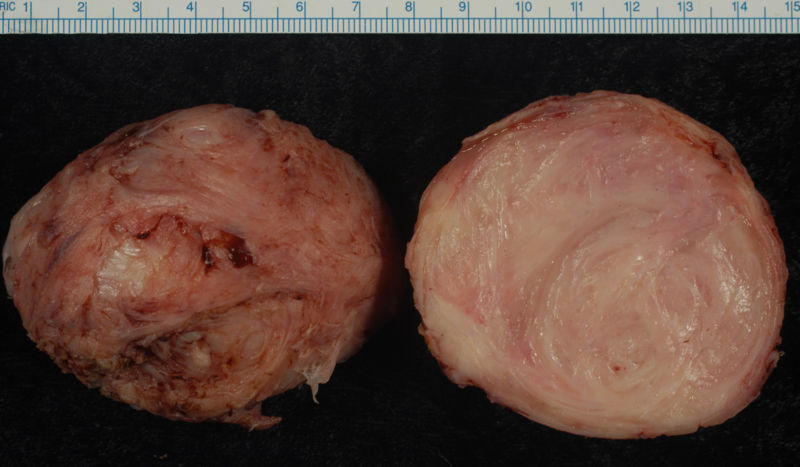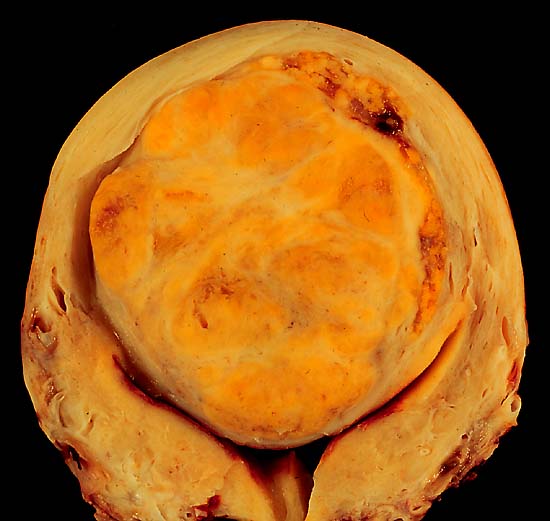Leiomyoma: Difference between revisions
Shanshan Cen (talk | contribs) No edit summary |
Shanshan Cen (talk | contribs) No edit summary |
||
| Line 34: | Line 34: | ||
==Related Chapters== | ==Related Chapters== | ||
* [[Myosarcoma]] | * [[Myosarcoma]] | ||
==Pathophysiology== | |||
===Uterine Leiomyomata=== | |||
{{main|Uterine fibroids}} | |||
Uterine fibroids are leiomyomata of the [[uterus|uterine]] smooth muscle. As other leiomyomata, they are [[benign]], but may lead to excessive menstrual bleeding ([[menorrhagia]]), often cause [[anemia]] and may lead to [[infertility]]. Enucleation is removal of fibroids without removing the uterus ([[hysterectomy]]), which is also commonly performed. [[Laser]] surgery (called myolysis) is increasingly used, and provides a viable alternative to surgery. | |||
Uterine leiomyomas originate in the [[myometrium]] and are classified by location: | |||
*Sub[[mucosal]] – lie just beneath the [[endometrium]]. | |||
*[[wiktionary:Intramural|Intramural]] – lie within the uterine wall. | |||
*Sub[[serous]] – lies at the serosal surface of the uterus or may bulge out from the [[myometrium]] and can become pedunculated. | |||
Estrogen and progesterone usually stimulate their growth, and hormone suppression may hence decrease their size. | |||
===Esophageal=== | |||
They are also the most common [[benign]] [[esophagus|esophageal]] [[tumour]], though this accounts for less than 1% of esophageal neoplasms. The remainder consists mainly of carcinomas. Although the vast majority of benign esophageal tumors are clinically silent and go undetected, large or strategically located tumors may become symptomatic. <ref name=AMN>{{cite web | author = James C. Chou, MD & Frank G. Gress, MD | title =Benign Esophageal Tumors | work =Esophageal Cancer Overview (Cancer of the Esophagus) | url=http://www.health.am/cr/benign-esophageal-tumors/ | publsiher=Armenian Health Network, Health.am | accessdate=2007-03-21}}</ref> | |||
===Leiomyoma of Jejunum=== | |||
Leiomyoma is the most common benign tumor of small bowel. Approximately 50% of cases are found in the jejunum, followed by the ileum in 31% of cases. Almost one half of all lesions are less than 5 centimeters. <ref name=ARO>{{cite web | author = By Michael P. Buetow, M.D. | title =Leiomyoma of Jejunum | url=http://www.appliedradiology.com/case/case.asp?ID=88&SubCatID=97&CatID=43&ThreadID= | publsiher=Applied Radiology Online | accessdate=2007-03-21}}</ref> | |||
===Gross Pathology=== | |||
<gallery> | |||
Image:leiomyoma.jpg|Leiomyoma enucleated from a uterus. External surface on left; cut surface on right | |||
Image:leiomyoma2.jpg|A large, solitary leiomyoma in the uterus, distoring the endometrial cavity into a Y shape by splaying and pressing it downwards. <br> (Image courtesy of Ed Uthman, MD) | |||
</gallery> | |||
{{Soft tissue tumors and sarcomas}} | {{Soft tissue tumors and sarcomas}} | ||
Revision as of 14:07, 9 December 2015
For patient information, click here
Editor-In-Chief: C. Michael Gibson, M.S., M.D. [1]; Associate Editor(s)-in-Chief: Cafer Zorkun, M.D., Ph.D. [2] Shanshan Cen, M.D. [3]
Synonyms and keywords:
Overview
Historical Perspective
Classification
Pathophysiology
Differentiating Leiomyoma from other Diseases
Epidemiology and Demographics
Risk Factors
Screening
Natural History, Complications and Prognosis
Diagnosis
Staging | History and Symptoms | Physical Examination | Laboratory Findings | X Ray | CT | MRI | Ultrasound | Other Imaging Findings | Other Diagnostic Studies | Biopsy
Treatment
Medical Therapy | Surgery | Primary Prevention | Secondary Prevention | Cost-Effectiveness of Therapy | Future or Investigational Therapies
Related Chapters
Pathophysiology
Uterine Leiomyomata
Uterine fibroids are leiomyomata of the uterine smooth muscle. As other leiomyomata, they are benign, but may lead to excessive menstrual bleeding (menorrhagia), often cause anemia and may lead to infertility. Enucleation is removal of fibroids without removing the uterus (hysterectomy), which is also commonly performed. Laser surgery (called myolysis) is increasingly used, and provides a viable alternative to surgery.
Uterine leiomyomas originate in the myometrium and are classified by location:
- Submucosal – lie just beneath the endometrium.
- Intramural – lie within the uterine wall.
- Subserous – lies at the serosal surface of the uterus or may bulge out from the myometrium and can become pedunculated.
Estrogen and progesterone usually stimulate their growth, and hormone suppression may hence decrease their size.
Esophageal
They are also the most common benign esophageal tumour, though this accounts for less than 1% of esophageal neoplasms. The remainder consists mainly of carcinomas. Although the vast majority of benign esophageal tumors are clinically silent and go undetected, large or strategically located tumors may become symptomatic. [1]
Leiomyoma of Jejunum
Leiomyoma is the most common benign tumor of small bowel. Approximately 50% of cases are found in the jejunum, followed by the ileum in 31% of cases. Almost one half of all lesions are less than 5 centimeters. [2]
Gross Pathology
-
Leiomyoma enucleated from a uterus. External surface on left; cut surface on right
-
A large, solitary leiomyoma in the uterus, distoring the endometrial cavity into a Y shape by splaying and pressing it downwards.
(Image courtesy of Ed Uthman, MD)
- ↑ James C. Chou, MD & Frank G. Gress, MD. "Benign Esophageal Tumors". Esophageal Cancer Overview (Cancer of the Esophagus). Retrieved 2007-03-21. Unknown parameter
|publsiher=ignored (|publisher=suggested) (help) - ↑ By Michael P. Buetow, M.D. "Leiomyoma of Jejunum". Retrieved 2007-03-21. Unknown parameter
|publsiher=ignored (|publisher=suggested) (help)

